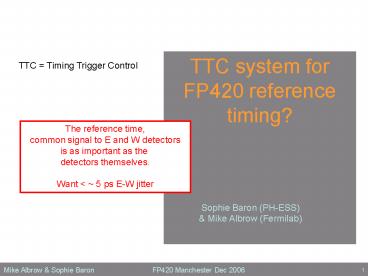TTC system for FP420 reference timing - PowerPoint PPT Presentation
1 / 11
Title:
TTC system for FP420 reference timing
Description:
Proposed Scheme for Reference Time transmission. Bunch Clock and Orbit to be transmitted ... need this from Christophe: http://conferences.fnal.gov/smallx07 ... – PowerPoint PPT presentation
Number of Views:39
Avg rating:3.0/5.0
Title: TTC system for FP420 reference timing
1
TTC system for FP420 reference timing?
TTC Timing Trigger Control
The reference time, common signal to E and W
detectors is as important as the detectors
themselves. Want lt 5 ps E-W jitter
Sophie Baron (PH-ESS) Mike Albrow (Fermilab)
2
Proposed Scheme for Reference Time transmission
Not really needed
- Bunch Clock and Orbit to be transmitted
- Level of radiation ?? . We will need
calculation of this. (Results here) - Clock monitoring between the 2 signals
- Goal 5 ps rms jitter skew between the clocks in
W and E
3
Existing system
- The TTC system
- Rad-hard chips
- Monitoring the phase between 2 optical signals
- Various transmission schemes used by the TTC
system - Typical jitter values
4
TTC system in one slide
This is standard equipment provided by LHC for
experiments
- Transmission of
- Timing of the LHC from the RF source to the
experiments - LHC Bunch Clock (40.078xx MHz)
- Revolution Frequency (11.245x kHz)
- Then combined inside the experiments with
- Trigger and Control signals
- Used by front-end electronics and readout systems
- Using single optical fibres
- and a lot of various components and modules
5
Radiation hard components
- TTCrx
- 50ps rms
- The TTCrx is now fabricated in the radiation-hard
DMILL technology, which completely eliminates the
possibility of a single-event latch-up, and
should show a high immunity to single-event upset
(SEU). - Tested up to 8 Mrad (X-Rays) and 5 x1013
n/cm2 (Neutrons) - QPLL
- 10-15ps rms
- Tested up to 10Mrad (Co-60 ?) 3 1015 n/cm2
- TRR receiver
- Optical receiver from Truelight (Taiwan) selected
for most of the TTC designs - Tested with the TTCrx at the same doses.
- OK if the optical power level stays above -20dBm
(0.1mW) - Optical Fibers
- sensitive to radiation (attenuation increases
with the dose) - Special fibres validated for ATLAS and CMS at
high radiation levels (1014-1015 n cm-2 and total
dose of 100 to 300 kGy) - Radiation hardness of multi-mode optical fibres
for the ATLAS detector readout (June 1999,DG
Charlton et all)
Phased locked loop voltage controlled Quartz
crystal oscillator (VCXO)
6
Transmission Schemes
- Encoded
- TTC inside the experiments (based on aTTCrx chip)
- Advantage Allows to encode the orbit signal (and
control frames) to the 40.078MHz - Drawback jitter increases with the quantities of
encoded data - QPLL added to reduce the jitter of the recovered
clock down to 10-15ps rms - We choose the alternative, better
resolution - Parallel
- TTC backbone system
- Orbit and clock on separate fibres
- Advantage very low jitter after the
opto-electrical conversion (lt10ps) without using
the QPLL
7
Parallel Scheme
- Clock and orbit on parallel fibres
- RF signal transmission scheme
Picture RF_Tx_D
Picture RF_Rx_D
Tx Board
Rx Board
- Laser Types
- OCP03 300
- OCP Tx 24 600
- Photodiode Types
- OCP Rx 03 230
- OCP Rx 24 300
- TRR 8 CHF!
8
Typical Jitter values Parallel Scheme
C1
OCP Tx 03
C3
C2
OCP Rx 03 fanout ECL driver
OCP Rx 03 fanout ECL driver
C1/C3 11.4ps
C2/C3 4.0ps
C1/C2 11.5ps
Lecroy Wavepro 7100 1GHz
9
Proposed Scheme for Reference Time transmission
WILL DO
Not really needed
- Bunch Clock and Orbit to be transmitted
- Level of radiation ?? . We will need
calculation of this. (Results here) - Clock monitoring between the 2 signals
- Goal 5 ps rms jitter skew between the clocks in
W and E
10
Conclusions There is
a Reference time signal solution with East-West
rms lt 5 ps. Proposal will be written for TDR by
Sophie Baron in consultation with MGA ( anyone
interested). We should ask for this to be
provided by CERN (will FP420 have to pay
something? If so, modest.)
11
- 6th Workshop
- Small x and Diffractive Physics
- 28-31 March 2007
- Fermi National Accelerator Laboratory, Batavia,
Illinois, USA - Just preceding FP420 April 2-3 UTA (Texas)
- The purpose of the Workshop is to present and
discuss experimental,phenomenological - and theoretical progress in high energy
diffractive interactions. - Results from the Tevatron, HERA and RHIC covering
small-xphenomena in the nucleon and nuclei,
large rapidity gaps, as well asrelevant cosmic
ray interactions will be presented. Attention
will be paidto the possibilities of measuring
exclusive Higgs bosons, vector bosonpairs, and
Beyond Standard Model phenomena at the LHC with
forward protonspectrometers." - Organizing Committee M.G.Albrow(FNAL),J.Bartels(
Univ.Hamburg), A.Brandt(UTA), - A.DeRoeck(CERN), K.Eggert(CERN),K.Goulianos(Rockef
eller Univ.), W.Guryn(BNL), - J.Huston(MSU), L.McLerran(BNL),
R.Orava(Helsinki),J.Repond(ANL),C.Royon(Saclay), - M.Ruspa(Torino), C.Sazama(FNAL) Co-chairs
- Contact Information C.Sazama, P.O.Box 500, MS
113, Batavia IL 60510 - tel 630-840-4102, email sazama_at_fnal.gov
- need this from Christophe http//conferences.fn
al.gov/smallx07































